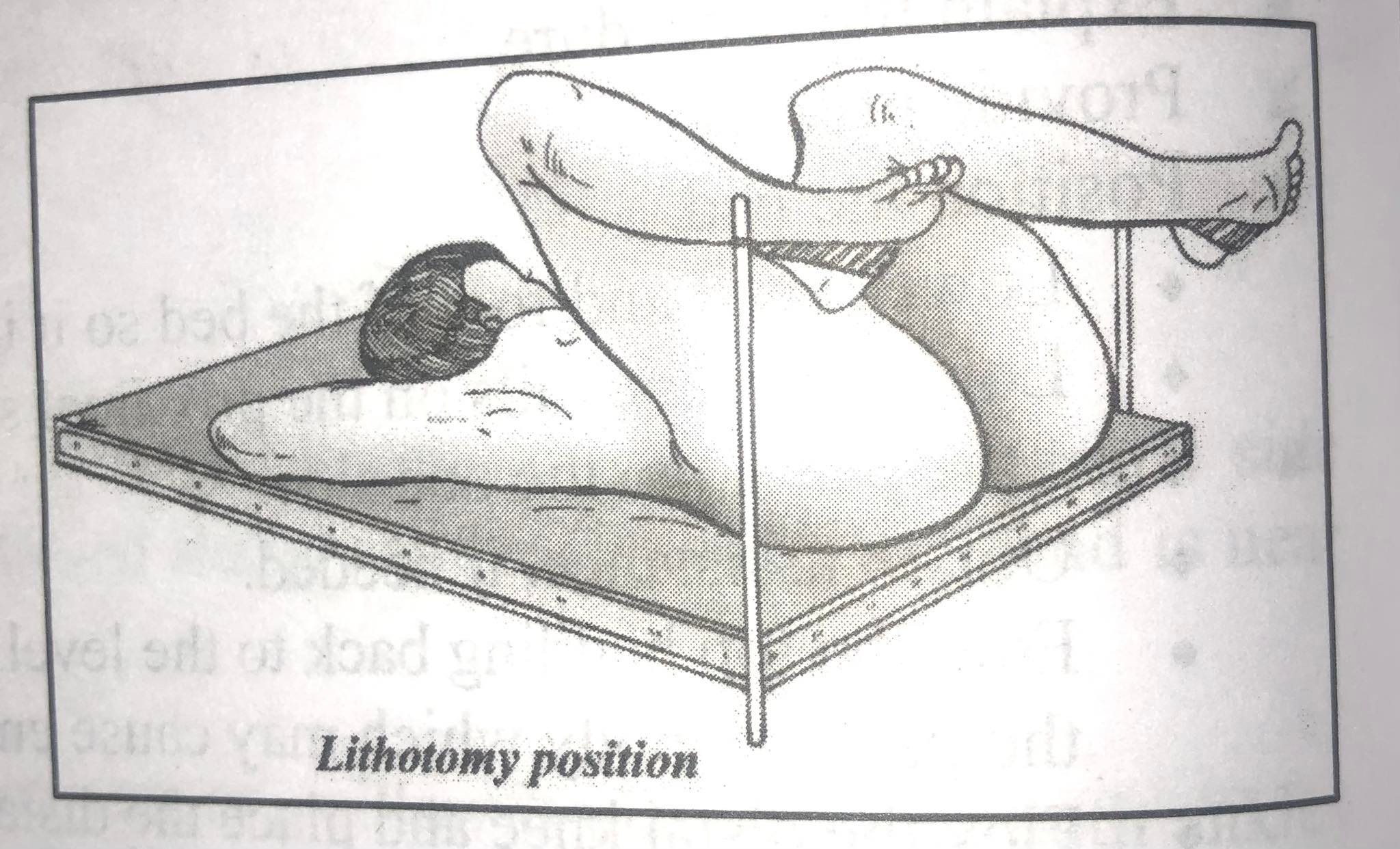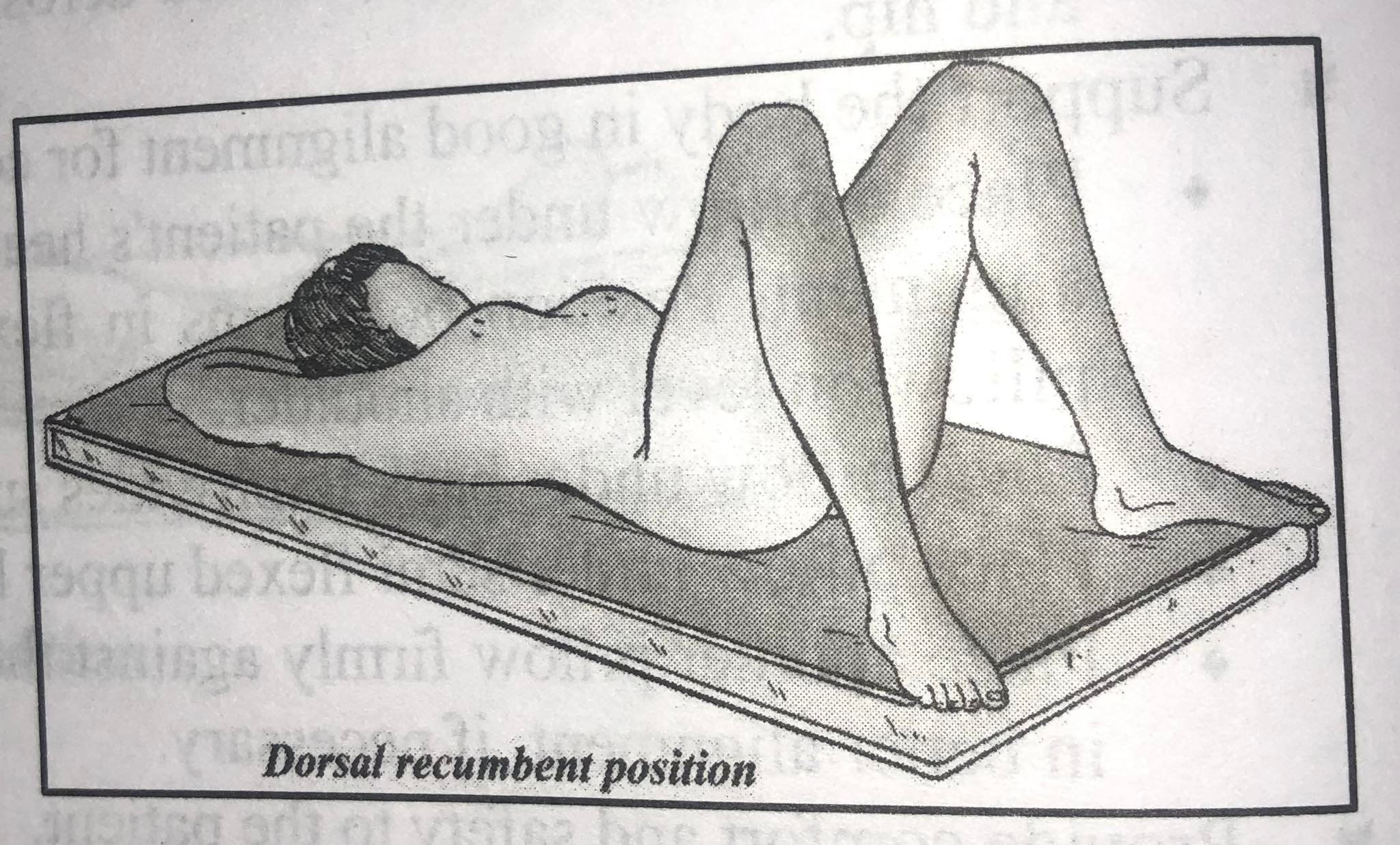Lateral-side Laying Position
Subject: Fundamentals of Nursing

Overview
Lateral/side Laying Position
The client lies on the side with weight on hip and shoulder or the patient lies on his side with both arms forward and his knees and hips flexed. The upper leg is flexed more than the lower leg. The upper knee and hip should be at the same level. A pillow is given head, back and front to support the arms and abdomen. A small pillow is given in between the knees.
Indication
- Patient who requires periodic position changes.
- In immediate post-operative patients to prevent the risk of aspiration.
- Used for examination of perineum or rectal inserting suppositories.
- Used for taking rectal temperature.
- Used for giving back care.
- Used for giving enema and colonic irrigation.
Procedure
- Explain the procedure.
- Provide privacy.
- Position the bed.
- Lower head and foot of the bed so it is level or flat.
- Lower the side rails on the proximal side; the distal side rail must be up.
- Turn the patient to the one side.
- Obtain assistance, if needed.
- Fold the top bedding back to the level of the patient's hips, but avoid undue exposure of the patient's body which may cause embarrassment.
- Flex the distal knee and place the distal arm across the chest.
- "Log-roll" the patient toward you by placing one hand on the shoulder and the other on the distal hip and pulling without twisting the patient's torso.
- Reach behind the patient's back with both hands, placing one on the proximal hip and lift slightly outward and roll the body toward you. wing shiver
- Align the patient's body in good position.
- Ensure the patient is not lying on his/her arm.
- Head, neck, and back are in a straight line.
- Legs are parallel with knees slightly flexed.
- Uppermost arm may be flexed across patient's abdomen or supported on his/her body and hip.
- Support the body in good alignment for comfort.
- Place a pillow under the patient's head and neck to prevent muscle strain and maintain alignment. Position both arms in flexed position. Upper most arms are supported by pillow on level with shoulder.
- Place pillow under back to provides support to maintain patient on side.
- Place pillow under semi flexed upper leg to support the knee.
- Place another pillow firmly against the patient's abdomen to support the back and hips in better alignment, if necessary.
- Provide comfort and safety to the patient.
- Replace the bedding neatly.
- Raise and secure the side rails.
- Place the call light within reach.
- Position the bedside stand and bed side table so that the patient is within easy reach of drinking water and personal items.
_1671860409.jpg)
Problems to be Prevented
- Lateral flexion and fatigue of sternocleidomastoid muscle.
- Internal rotation and adduction of shoulder and limited chest expansion.
- Internal rotation and adduction of femur and twisting of spine.
Lithotomy
The client lies supine with hips flexed. The legs are separated and thighs are flexed on the abdomen and legs are on the thighs. The patient's buttocks are kept at the edge of the table and legs are supported by stirrups.
Indications
- For delivery of baby.
- For rectal examination & surgeries e.g. hemorrhoidectomy.
- For vaginal examination and hysterectomy.
Procedure
- Explain the procedure to the patient.
- Provide privacy.
- Position the patient to lie on his back with one pillow under the head.
- Keep the legs well separated and the thighs are well flexed on the abdomen and the legs on the thighs.
- Buttocks are kept on the edge of the table and the legs are supported on stirrups.

Dorsal Recumbent Position
Dorsal means "back," and recumbent means "lying down." So the dorsal recumbent position literally means lying down on the back. The client is positioned with the legs spread apart and knees bent with feet flat on the table.
In this position clients with painful disorders are more comfortable with knees flexed. This position should not be used for abdominal assessment because it promotes contraction of abdomen muscles.
Indications
- It is used for catherization, vaginal douche, vulval, vaginal and rectal examination.
- It is also used for vaginal operations and insertion of tampons.
Procedures
- Place the patient on back in bed with two or more pillows under the head for patient's comfort.
- Place the air ring under the hips and cotton rings or foam pads under the heels to reduce pressure.
Fowler's Position
It is a sitting position in which the head is elevated at 45 to 60 degrees, and the client knees are slightly elevated, avoiding pressure on the popliteal vessels. Backrest and two pillows are used for the back and head. Pillows can be used to maintain natural alignment of the hands wrist and forearms. Variations of fowler's position include high fowler's and low fowler's or semi fowler's position.
High Fowler's Position: This is sitting position, raises the client's head 80-90 degrees. Pillow can be used under the head and arms and a footboard may be used.

Semi Fowler's: In this position the client's head is elevated only at 30-45 degree.
Indications
- To relieve dispnoea.
- To improve circulation.
- To relax the muscles of the abdomen, back and thighs.
- To relieve tension on abdomen suture.
Procedure
- Explain the procedure to the patient.
- Collect equipment.
- Pillows.
- Positioning aids as indicated.
- Wash your hands.
- Provide privacy throughout the procedure.
- Position the bed.
- Place the bed in a flat or level position at working height, unless contraindicated.
- Lower the side rails on the proximal side (as necessary).
- Be sure the patient is in a supine position with his head near the top of the bed.
- Elevate the head of bed (Fowler 45-90 degrees, Semi 15 to 45 degrees, High 90 degree).
- Use a footboard to maintain the feet at right angles to the legs.
- Use pillows for support as needed.
- Behind the shoulders and head to prevent flexion and hyperextension of the neck.
- Behind the lower back to prevent posterior convexity of the lumbar spine region.
- Under the thighs to prevent hyperextension of the knees.
- Place the patient in good body alignment.
- Head, neck, and back are straight.
- The weight of the body is supported where the hips are flexed in the sitting position.
- Feet are straight.
- Toes are pointing up.
- Provide for the patient's comfort and safety.
- Replace bedding neatly.
- Raise and secure the side rails.
- Place the call light within reach.
- Position the bedside stand or bedside table so that the patient will be within easy reaches of drinking water and personal items.

Problem to be Prevented
- Posterior flexion of lumber curvature.
- Hyperextension of neck.
- Edema of hands and arms.
- Possible dislocation of shoulder.
- Hyper extension of the knees.
- External rotation of hips pressure on heels.
- Planter flexion of feet.
Things to remember
© 2021 Saralmind. All Rights Reserved.

 Login with google
Login with google